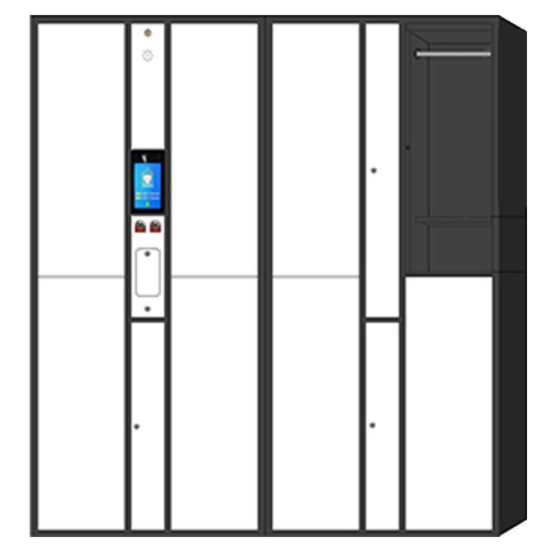I. Basic Functions and Principles of Mobile Phone Charging Cabinets
Mobile phone charging cabinets are intelligent devices that integrate charging, storage, and management functions. They achieve centralized control of employees' mobile phones through a combination of physical isolation and electronic management. Modern smart charging cabinets typically possess the following core functions:
1. Multi-compartment design: Each compartment is equipped with an independent lock, allowing simultaneous storage of multiple mobile phones.
2. Smart charging system: Supports multiple interfaces (USB-C, Lightning, etc.), automatically identifying devices and matching the optimal charging power.
3. Access control system: Controls access permissions via IC cards, fingerprints, facial recognition, or passwords.
4. Remote monitoring function: Administrators can view usage records, compartment status, and other information through the backend.
5. Anomaly alarm system: Issues alarms for unauthorized opening, exceeding storage time limits, etc.
II. Specific Scheme for Unified Mobile Phone Management
(I) Preliminary Planning and Deployment
1. Requirements Analysis:
- Count the number of employees to determine the charging cabinet capacity requirements.
- Understand the company's existing access control system and consider compatibility issues.
- Clarify management objectives (e.g., disabling mobile phones during work hours or limiting use to emergency situations).
2. Equipment Selection:
- Select a smart charging cabinet system with good scalability.
- Consider cabinet material (fireproof, tamper-proof), charging safety (overcharge protection)
- Assess whether customized functions are needed (e.g., disinfection, temperature control)
3. Installation location selection:
- Office entrance or public area
- Ensure good ventilation and stable power supply
- Consider employee accessibility
(II) Management System Establishment
1. Establish usage guidelines:
- Specify storage time (e.g., storage is mandatory after clocking in)
- Specify emergency access procedures
- Establish penalties for violations
2. Hierarchical access control:
- Regular employees: Can only use designated storage compartments
- Department heads: Emergency access permission
- Administrators: Full access permission
3. Data management policy:
- Specify the retention period for usage records
- Specify the data retrieval approval process
- Ensure compliance with personal information protection regulations
(III) System Integration and Intelligent Management
1. Integration with existing enterprise systems:
- Link with the attendance system to automatically record storage/retrieval time
- Integration with access control systems for unified card management
- Integration with OA systems for push notifications
2. Intelligent Function Development:
- Develop mobile apps or WeChat mini-programs for employees to easily check storage cell status
- Implement reservation functions to avoid queues during peak hours
- Set intelligent reminders (e.g., full charge reminders, overdue storage reminders)
3. Data Analysis Application:
- Statistical analysis of storage rates for each department to assess system implementation
- Analyze peak periods to optimize cabinet configuration
- Improve management measures through data utilization
III. Implementation Effect Evaluation and Optimization
(I) Short-Term Effect Evaluation
1. Changes in Work Efficiency:
- Evaluation through indicators such as task completion rate and work focus
- Collection of employee feedback to understand actual user experience
2. Equipment Usage:
- Statistical analysis of storage rate, violation rate, etc.
- Evaluation of equipment stability and failure rate

3. Management Cost Analysis:
- Comparison of management costs before and after implementation
- Calculation of return on investment
(II) Long-Term Optimization Directions
1. Technology Upgrade:
- Introduce AI recognition technology to improve management efficiency
- Add wireless charging functionality to adapt to future device development
- Develop a more intelligent allocation algorithm
2. System Improvement:
- Adjust management systems based on actual operational conditions
- Establish a more flexible emergency mechanism
- Optimize reward and punishment measures
3. Cultural Development:
- Integrate mobile phone management into corporate culture
- Cultivate self-discipline habits through positive incentives
- Organize relevant themed activities
IV. Implementation Considerations
1. Privacy Protection:
- Ensure the system does not access data on mobile phones
- Clearly inform employees of the monitoring scope
- Comply with relevant laws and regulations
2. Emergency Support:
- Set up backup power supplies
- Retain mechanical opening methods
- Establish a rapid response mechanism
3. Humanized Management:
- Consider the communication needs of special positions
- Provide convenience for special groups such as breastfeeding employees
- Avoiding Rigid "One-Size-Fits-All" Management
Through scientific planning, reasonable implementation, and continuous optimization, mobile phone charging cabinets can become an effective tool for enterprises to improve work efficiency and standardize employee behavior, while also finding a balance between protecting employee rights and enterprise management needs. The key lies in combining technological means with management skills to form a sustainable mobile phone management system.

















 WhatsApp
WhatsApp Phone
Phone
Comment
(0)